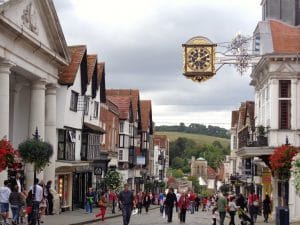Reimagining the High Street
Before Covid-19 changed the world we live in, the ‘High Street’, or more importantly ‘the future of the High Street’ was already a major issue debated in society, property development and across the professions. Motion Regional Director John Russell sets out his key themes for rethinking the town centre by putting people at its heart, with implications for planning, policy development and design.
From my experience, many retail outlets in my local town centre closed during the 2008 recession. More than ten  years later, many of these retail units remain either empty or in use on a seasonal or temporary basis. Some retailers did not return to the town; others including Woolworths simply ceased to exist. Over the same period, there has been a steady increase in online shopping – especially for non-food purchases where the internet provides a global shop window for product lines which are not reliant on freshness. But food delivery has also become a commonplace sight on our streets, with a rapid increase in home delivery services by the major food retailers and even the establishment of online-only grocers.
years later, many of these retail units remain either empty or in use on a seasonal or temporary basis. Some retailers did not return to the town; others including Woolworths simply ceased to exist. Over the same period, there has been a steady increase in online shopping – especially for non-food purchases where the internet provides a global shop window for product lines which are not reliant on freshness. But food delivery has also become a commonplace sight on our streets, with a rapid increase in home delivery services by the major food retailers and even the establishment of online-only grocers.
The past few months of lockdown have, through necessity, seen an acceleration in what was already a growing retail trend towards home delivery. The longer retail restrictions continue, the more likely people are to have developed the habit of home delivery, and the less likely we are to see a wholesale return to physical visits to shops.
Making movement of pedestrians and cyclists safe, easy and enjoyable
These changing retail patterns raise significant questions for how we design places for people to move from, to, and around. Town centres have historically fuelled demand for car parking, and access to the spaces by car. Pedestrian and cycle access, if designed for, is to cater for people moving between the car park and the town centre.
However, if the face of the town centre changes to include more retail, leisure, residential and specialist food retail uses, as well as fewer outlets selling more bulky items such as TVs and fridges, how necessary is it for town centres to retain large volumes of car parking? Should they be designed instead to make travel a pleasant, easy and safe experience by foot or cycle?


Would the conversion of car parking and highway space to high-quality public realm, in which the pedestrian is king, improve the viability of a reborn town centre? The government’s announcement that it will be putting forward £2 billion to improve the walking and cycling environment provides a great opportunity to design and build meaningful schemes which can both deliver walking and cycling infrastructure improvements and at the same time, if planned carefully, transform the quality of town centres in order to encourage more people to visit them.
Adopting a flexible and pragmatic approach to car parking and design standards
This transformation will need a flexible and pragmatic approach to be taken by local authorities. Many of these continue to rigidly apply car parking requirements and highway design standards that predate the National Planning Policy Framework and, in some cases, even the release of the Manual for Streets in 2007. This has resulted in town centre redevelopment that continues to be dominated by vehicular movement.
This is not to say that town centres do not need car parking or infrastructure for vehicular traffic. Rather, local authorities could consider redevelopment in town centres on a case-by-case basis – listening closely to what developers say about the access and car parking they consider is necessary, instead of employing minimum or maximum design standards. Similarly, more flexibility is needed in applying a ‘town centre’ line on a development plan, based on type and operation of the development rather than its proximity to a geographical point. This would enable a feathering of the town centre and its immediate hinterland to create an environment that attracts people towards the town centre, rather than it being isolated behind an arbitrary line on a development plan.
Applying open-mindedness in application of design guidance for residential streets
Attention must also be given to the ‘home’ end of ‘home delivery’. Historically, little commercial traffic might have been expected in residential streets and they have tended to be designed accordingly. The days of the neighbour’s curtains twitching when a home delivery van was spotted in the street, in order to see from which shop the ‘Joneses’ bought their new sofa, are already gone, as home delivery vehicles become ubiquitous. However, with increasing volumes of home delivery commercial traffic using residential streets that were not designed for such uses, is there a need to revisit standards?


There is a strong argument that residential streets should be designed to accommodate frequent commercial vehicle movements, based on likely future trends in home delivery. But the gains made over the past 20 years in designing residential streets to a human scale must not be thrown away. Instead, the challenge is to think laterally about how to best accommodate commercial traffic without compromising the integrity and quality of our streets. In order to balance the competing needs for road space, open-mindedness and flexibility will be key in the application of design guidance by permitting authorities.
An abridged version of this article appeared in the Autumn 2020 issue of Insight


